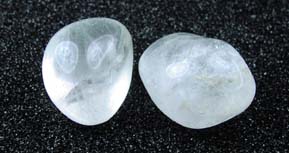Piezo-electricity was discovered in 1880 by Pierre Curie and his brother Paul-Jean Curie using crystals. Quartz and rochelle salt have strong piezo-electric properties, see figure 3.
By definition; piezoelectric materials when mechanically deformed generate an electric charge. Conversely it was also discovered, when an external electric field is applied to piezo-electric materials they mechanically deform (change their physical dimensions.) One of the first practical uses of this second piezo- electric property was to create ultra-sonic transducers to create underwater SONAR.
Piezoelectric Bone
Living bone is also piezo-electric. Piezo-electric charges develop when a bone is stressed through normal activity and movement. These electric charges keeps the bone healthy. When a bone is broken or becomes fractured from an accident, piezo-electric voltages help promote bone healing.
Physicians have learned to use this information to help mend hard to heal bone fractures and breaks common in elderly patients. Knitting of the bone material is helped along by an external device that produces tiny pulses of electric current at the fracture site.
Piezoelectric-Light
Triboluminescence (TRI-bow-loom-en-NES-ence) is a light producing phenomenon that occurs when striking or rubbing two pieces of piezo-electric material together. The most common materials that exhibit triboluminescence are quartz and quartzite, rose quartz. Chose quartz specimens that are translucent rather than transparent, with minimal fractures throughout the rock see figure 4.

The phenomenon is easy to demonstrate provided you have the right materials. Take the rock specimens into a dark room. Wait a minute for your eyes to become dark adapted. Then strike the specimens together quickly. At the point of impact you should see a light flash. Continued striking of the rocks will continue to produce light flashes. Not all specimens will exhibit triboluminescence. Images Co. sells triboluminescence specimens see parts list.
A few years ago a lot of people played with triboluminescence using wintergreen-flavored Lifesavers (TM) candy. This is easy to play with. In a dark room, place the candy between the jaws of a plier and crush it. You will see a bright flash. Crush the remaining pieces in a mortar and pestle for another visual effect.
Exactly how these rocks produces the light flashes hasn't been determined. One theory is that the impact causes electrons to jump to a higher energy shell. When the electrons jump back to the original shell orbit they release energy that creates the light.

